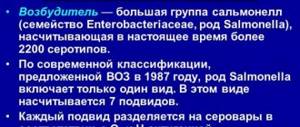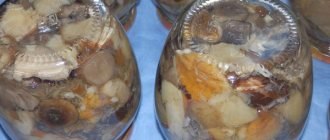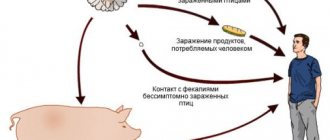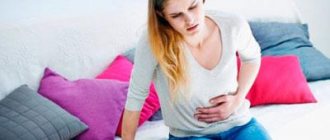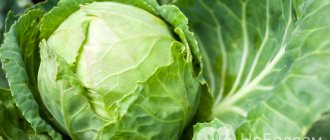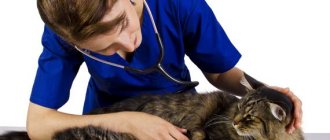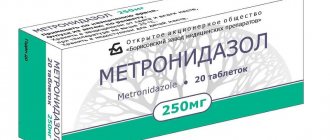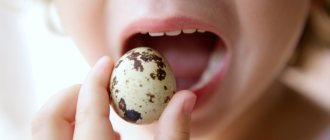Causes
Toxic infection is an intestinal disorder of the digestive system caused by eating spoiled foods.
The food may also be contaminated. Symptoms vary depending on the type of pathogen. Common sources of infection:
- some food products: canned food, dairy products, cream, eggs and meat;
- contact with animals, especially street ones;
- other infected people.
Usually a large group of people become infected at once. Children are at risk, since the acidity of their stomach does not suppress even the simplest bacteria. Outbreaks of food poisoning occur more often in the warm season due to the shortening of the shelf life of products.
Toxic infection can manifest itself in different ways: nausea, vomiting, diarrhea, attacks of gastritis and increased swelling.
Pathogens
Any type of bacteria can settle on the skin of a person or animal. Children with weakened immune systems are at risk. More often than others, cows and sheep catch purulent diseases.
The provocateur of food or surface contamination is a purulent disease such as furunculosis, tonsillitis or panaritium. When cooking, bacteria can spread to the untreated surface of meat or vegetables and cause poisoning in other family members or colleagues.
What pathogens most often provoke toxic infection:
- enterococcus;
- staphylococcus;
- shigella;
- coli;
- salmonella;
- Proteus;
- clostridia.
Any pathogenic bacteria can cause symptoms. Contact with the surface of vegetables or fruits can be accidental if hygiene rules are not followed. Sometimes pathogens take root on soil, water and other environmental surfaces.
Transmission routes
Prolonged contact is not necessary to transmit the pathogen. Harmful microorganisms quickly adapt to the new environment, colonizing its surface. However, there must be a large amount of decomposition products.
Most often, pathogens attack dairy products, fish, meat and confectionery dishes. Eggs are at risk because essentially fecal-oral contact occurs between humans and chickens.
Clostridia infects animal products: chicken, pork and beef. Vegetative propagation is typical under conditions of repeated thawing or frequent heating of food. It is not always possible to determine the presence of a pathogen by smell and taste.
Risk factors
All people are susceptible to food poisoning, but there are categories of people who get sick more often than others. These are those who consume contaminated food.
At risk:
- young children;
- newborns;
- people with weakened immune systems;
- patients who have recently suffered from viral and infectious diseases;
- treated with antibiotics;
- people in the postoperative period.
Also, the degree of susceptibility depends on the history of diseases. Immune defense may be weakened by intestinal pathologies. Resistance is also reduced during the period of receiving doses of chemotherapy and radiation therapy.
The incubation period for food poisoning is short. The first symptoms may appear within a few hours. The acute condition persists for up to 2-3 days.
There are two options for intoxication:
- enteroviruses;
- cytobacteria.
The latter case is a severe degree of the disease, in which, in addition to general symptoms, general dehydration of the body is observed. If enterobacteria are capable of causing habitual food poisoning, then cytotoxins affect the functioning of other internal organs and systems, this can have negative consequences on the body even after recovery.
In fact, food toxins affect bacteria, as a result of which these disease symptoms develop. Because of this, the pathogen is not released. The bacteria themselves can adapt to conditions and often tolerate the effects of antibacterial drugs and disinfectants well, which makes treatment difficult.
People and animals become the source and reservoir of bacteria. Basically, people who secrete this type of bacteria suffer from purulent inflammatory diseases. However, a healthy person can also become a carrier of food poisoning. Among the animals, the carriers are cattle, which are sick with mastitis.
Bacteria enter food products, where they quickly multiply, and then penetrate the body through the food route. Foodborne illness occurs when a person has consumed food containing a large amount of these microorganisms. Their rapid reproduction is typical for meat products, fish, semi-finished products, minced meat and dairy products.
The appearance of food poisoning can occur in isolated cases (most often at home), as well as in mass outbreaks (if many people, for example, a whole team, ate similar products).
People's susceptibility is quite high, but in everyone, food poisoning occurs with varying degrees of severity. For example, children, the elderly and patients after surgery are at risk. In such people the course can be much more severe. Children can be exposed to food poisoning not only due to reduced immunity, but also as a result of contact with various objects and playing outside.
Infectious diseases
4.5. Foodborne illnesses
Foodborne illnesses (FTIs) are acute, short-term diseases caused by opportunistic bacteria capable of producing exotoxins outside the human body (in food), and occurring with symptoms of damage to the upper gastrointestinal tract (gastritis, gastroenteritis) and water-salt disorders exchange.
PTI occupy an intermediate position between typical food infections and food intoxication (poisoning). They proceed similarly to intoxications, like acute gastrointestinal diseases, but at the same time they are contagious, since pathogens multiply both in food products and in the human body. The clinical picture, depending on the conditions, may be similar to both intoxication and infection. In the practice of an infectious disease doctor, there are two principal variants of the course of acute intestinal infections: foodborne toxic infections and infectious diseases of the gastrointestinal tract.
Historical information. Even in ancient times, it was known that the consumption of food products in some cases can cause diseases accompanied by vomiting and diarrhea. It was assumed that this was due to the incompatibility of food products, pathogenic natural properties or the content of toxic substances in them. In the last century, it was noted that some “food poisoning” is associated with the consumption of meat from sick animals (Beijing M., 1812; Bollinger O., 1876; etc.). It was later found that such diseases can be caused by food products of animal and non-animal origin infected with opportunistic bacteria and their toxins. One of the first descriptions of the clinical picture of staphylococcal food intoxication belongs to P. N. Lashchenkov (1901). To date, there is a large amount of information about the role of opportunistic microflora and the exotoxins it produces in the development of PTI. These data suggest that, unlike other infectious diseases, for the occurrence of PTI, the obligatory conditions are not only the presence of microorganisms in food products, but, most importantly, the accumulation in them of a sufficient dose of exotoxins produced by bacteria.
Bacterial food poisoning is divided into toxic infections and toxicosis (intoxication). The latter include diseases caused by Cl. botulinum and enterotoxigenic strains of St. aureus. Due to the pronounced difference in the mechanism of action of the toxin (neuroplegic effect) secreted by Cl. botulinum, and the peculiarities of the clinical picture of botulism are described separately. Staphylococcal intoxication, which is similar in clinical picture to foodborne toxic infections, is presented in this section.
Etiology. The causative agents of PTI include many types of opportunistic bacteria that are capable of producing exotoxins during their life outside the human body in various food products. Among the exotoxins are enterotoxins (heat-labile and heat-stable), which enhance the secretion of fluid and salts into the lumen of the stomach and intestines, and a cytotoxin, which damages the membranes of epithelial cells and disrupts protein synthetic processes in them.
The most common pathogens of PTI that can produce exotoxins in food before consumption are Staphylococcus aureus, Bacillus cereus, Clostridium botulinum. Pathogens such as Clostridium perfringens, Bacillus cereus, Clostridium botulinum, enterotoxigenic E. coli, Vibrio cholerae O1, O139, Vibrio cholera non-O1, Shiga toxin-producing E coli, along with the production of toxins in food products outside the human body, have the ability continue the production of toxins after penetration into the patient’s gastrointestinal tract.
Foodborne toxic infections are most often caused by Staphylococcus aureus and Bacillus cereus, less commonly by Clostridium perfringens, Clostridium botulinum (see subsection “Botulism”), Vibrio parahaemolyticus, Aeromonas hydrophila, etc.
Among PTI, the unique clinical and morphological manifestations are the disease caused by Clostridium difficile, a strict anaerobe, which is part of the normal residual intestinal microflora (0.01 - 0.001% of the total microflora). C. difficile occurs in 2–3% of the adult population. The clinical picture of infection caused by C. difficile has a wide range of manifestations from mild enterocolitis to severe pseudomembranous colitis.
Epidemiology. The causative agents of PTI are widespread in nature and are found everywhere: in the feces of people and animals, in soil, water, air, and on various objects, so it is usually not possible to determine the source of PTI. However, in some cases, when the sources are persons working in the food industry and suffering from various pustular skin diseases (pyoderma, felon, purulent wounds, etc.) or sore throats, nasopharyngitis, laryngotracheobronchitis, pneumonia, their identification is not only necessary, but also possible. Among the zoonotic sources of PTI, animals with mastitis can be identified - cows, goats, sheep, etc. The transmission mechanism of this group of diseases is fecal-oral.
PTIs are spread through nutrition. Among the factors for the transmission of PTI are solid (sausages, jellies, eggs, canned meat and fish, etc.) and liquid (soup, milk, juices, compotes, jelly, kvass, lemonade, beer, cocktails, etc.) food products that are suitable for bacteria nutrient medium. Staphylococcal intoxication is most often associated with consumption of infected milk and dairy products, confectionery creams, meat, fish and vegetable dishes. Proteus and clostridia reproduce well in protein products (meat, fish, including canned fish, sausage, milk). Bac. cereus is very unpretentious, multiplies rapidly in various food products: vegetable salads and soups, puddings, meat and fish dishes.
According to some authors, PTI accounts for the majority of all food-borne microbial diseases. In 2011 in Moscow, 98.1% of the overall structure of AEIs were AEIs of unknown etiology, of which 53.5% were PTI. In the Russian Federation, the proportion of etiologically undeciphered OKIs and PTIs ranges from 62 to 68%.
Susceptibility to this group of diseases is high. It is not uncommon for 90–100% of people who consume the contaminated product to become ill. Characteristic of IPT is not only the group, but also the explosive nature of the incidence, in which in a short time (within a few hours) all participants in the outbreak fall ill.
The incidence of PTI is recorded throughout the year, but more often in warm weather, since during this period it is more difficult to ensure impeccable storage of prepared food products.
Pathogenesis and pathological picture. In case of food toxic infections (and intoxications), by the time food enters the stomach, in addition to bacteria, it contains a significant amount of exotoxin. This determines the development of the shortest incubation period in infectious pathology. In some cases, from the moment of exposure to toxins on the gastric mucosa to the development of clinical symptoms, no more than 30 minutes pass (usually 2–6 hours).
The pathogenesis and clinical picture of PTI largely depend on the type and dose of exotoxin, as well as other toxic substances of bacterial origin contained in the food product.
Enterotoxins (heat-labile and heat-stable), binding to the epithelial cells of the stomach and intestines, affect the enzymatic systems of epithelial cells without causing morphological changes in these organs. Among the enzymes activated by enterotoxins are adenylate cyclase and guanylate cyclase, which increase the formation of biologically active substances in the cells of the mucous membrane - cAMP and cGMP. Under the influence of toxins, the rate of formation of prostaglandins, histamine, intestinal hormones, etc. also increases. All this leads to increased secretion of fluid and salts into the lumen of the stomach and intestines and the development of vomiting and diarrhea.
The toxin damages the membranes of epithelial cells and disrupts protein synthetic processes in them. This can increase the permeability of the intestinal wall to various types of toxic substances (lipopolysaccharides, enzymes, etc.) of bacterial origin, and in some cases, the bacteria themselves. All this leads to the development of intoxication, impaired microcirculation and local inflammatory changes in the mucous membrane.
Thus, the clinical manifestations of PTI caused by pathogens capable of producing only enterotoxins are less severe; in most cases, the diseases occur without hyperthermia and any significant inflammatory changes in the mucous membrane of the stomach and intestines. The same cases when there is an accumulation of both enterotoxins and cytotoxins in food products are much more severe, with short-term but high fever, inflammatory changes in the mucous membrane of the gastrointestinal tract.
The short-term nature of the course of PTI is associated with the short stay of their pathogens in the human body. The action of toxins that bind to the epithelial cells of the stomach and intestines ceases after the desquamation of these cells. Unbound toxin molecules are inactivated by proteases.
Only under certain conditions, when the antibacterial defense system of the small intestine is impaired as a result of previous diseases, can PTI pathogens remain in the intestine for a longer period of time. In some cases, as happens, for example, in patients with malnutrition, after gastrectomy, with blind loop syndrome, the colonization of the small intestine with Cl. perfringens type C leads to severe necrotic enteritis.
The pathological picture of PTI has been little studied. In rare cases of death, swelling, hyperemia of the mucous membrane of the stomach and small intestine, and sometimes desquamation of the epithelium are found. In other organs, dystrophic changes of varying degrees are detected, which developed as a result of intoxication and hemodynamic disturbances.
In case of infection caused by C. difficile, the main factors of damage are toxin A (a powerful enterotoxin with cytotoxic activity, causing disruption of the barrier function of the intestinal mucosa due to damage to epithelial cells and activation of fluid secretion into the intestinal lumen) and toxin B (cytotoxin, 1000 times more a more powerful cytotoxin than toxin A, its cytotoxic effect is due to disruption of the polymerization of intracellular actin filaments), and some strains synthesize an actin-ATP-ribolizing toxin.
C. difficile toxins cause profound changes in the intestinal mucosa, including perforation. Some antibiotics, especially lincomycin, clindamycin, ampicillin, induce the production of cytotoxin, increasing its level by 16–128 times. A severe variant of infection caused by C. difficile is pseudomembranous colitis.
Clinical picture. The incubation period lasts from 30 minutes to 24 hours (usually 2 – 6 hours). The clinical picture of PTI caused by various pathogens has much in common and is represented by similar symptoms. The onset of the disease is acute. Nausea appears, followed by vomiting. Vomiting rarely happens once, more often it is repeated, sometimes indomitable, painful, debilitating, and diarrhea begins almost simultaneously with vomiting. The stool is loose, watery, from 1 to 10 – 15 times a day, usually of an enteritic nature and does not contain mucus or blood. In a significant proportion of patients, the disease is not accompanied by any severe abdominal pain or fever. At the same time, a considerable number of cases of PTI occur with cramping pain in the epi- and mesogastrium and short-term hyperthermia. In the clinical picture of these diseases, in addition to gastrointestinal symptoms, chills, increased body temperature, moderate headache, weakness, and malaise are observed. The temperature rises to a maximum (38–39 °C) in the first hours of illness, and after 12–24 hours it usually drops to normal.
Objectively, patients have pallor of the skin, sometimes cyanosis, and coldness of the extremities. The tongue is covered with a white-gray coating. The abdomen is soft on palpation, painful in the epigastrium, less often around the navel. The cardiovascular system naturally suffers: bradycardia is detected (with hyperthermia - tachycardia), blood pressure is reduced, a systolic murmur is heard at the apex of the heart, and muffled heart sounds. In some cases, fainting and short-term collaptoid states develop. With repeated vomiting and profuse diarrhea, symptoms of dehydration, demineralization and acidosis may appear. Possible cramps in the muscles of the limbs, decreased diuresis, decreased skin turgor, etc. With timely adequate therapy, these phenomena quickly stop. The liver and spleen are not enlarged. In the hemogram: leukocytosis, neutrophilia, moderate increase in ESR. The disease in most cases lasts 1–3 days.
The manifestations of PTI depend little on the type of pathogen, however, in some cases, some etiologically determined originality of the clinical picture of the disease can be detected.
Thus, the range of clinical manifestations of IPT caused by Cl. perfringens, quite wide. Along with mild diseases, the clinical picture of which is dominated by symptoms of gastritis or gastroenteritis, there are also severe forms of the disease, accompanied by the development of necrotic enteritis and anaerobic sepsis.
In IPT caused by Proteus, the stool has a strong foul odor. Some patients experience a short-term decrease in visual acuity and other visual disturbances.
Staphylococcal intoxication often occurs without diarrhea. The clinical picture is dominated by symptoms of gastritis in the form of repeated vomiting and cramping pain in the epigastric region. Signs of vascular dystonia are noted. The body temperature of most patients is normal or subfebrile.
Pseudomembranous colitis, the etiological factor of which is C. difficile, develops in cases of previous use of antibiotics. The main antibiotics associated with the development of pseudomembranous colitis include cephalosporins (especially 2nd and 3rd generations), ampicillin, amoxicillin and clindamycin. Less significant are macrolides (erythromycin, clarithromycin, azithromycin) and other penicillins. Long-term use of antibiotics or simultaneous use of two or more antibacterial drugs further increases the risk of developing pseudomembranous colitis.
Consequently, pseudomembranous colitis is a consequence of the development of a kind of “clostridial” dysbiosis in patients under the influence of various predisposing factors. The disease develops when C. difficile develops resistance to antibiotics that suppress the vital activity of other intestinal microflora. In this case, the pathological process in the colon is caused only by the action of toxins, while clostridia themselves do not have invasive properties and, as a rule, do not penetrate the submucosal layer.
The symptoms of pseudomembranous colitis are very variable, since the disease complicates the course of the underlying pathological process for which antibiotics were prescribed. Clinical manifestations are possible both during the period of antibacterial therapy and 1–10 days after cessation of treatment. A more delayed development of colitis is possible (6 to 8 weeks after antibiotic therapy).
The clinical picture is characterized by loose stools, abdominal pain and fever, the severity of which can vary widely. The clinic is dominated by diarrhea syndrome with stool frequency up to 20–30 times, which in some cases is the only manifestation of the disease. The stool is usually watery and of small volume, but due to the frequency of bowel movements, patients may develop fluid and electrolyte disorders of varying severity. Diarrhea is persistent and can persist for up to 8–10 weeks. Sometimes stool disorder can be intermittent: diarrhea is replaced by formed stools that persist for one to two days. Often the stool contains an admixture of mucus and, in some cases, blood. Vomiting is usually rare and its occurrence indicates the severity of the disease.
Along with diarrhea, patients experience abdominal pain of varying intensity, predominantly of a spastic nature, intensifying with palpation of the abdomen. Most often, the pain does not have a clear localization and is determined along the large intestine.
Sometimes the disease can begin with fever, the body temperature of patients remains at febrile levels, but in recent years cases of the disease have become more frequent, in which hectic fever exceeding 40 °C is recorded.
Complications of IPT. Complications include dehydration shock and acute heart failure associated with disturbances in electrolyte metabolism (hypokalemia). Other complications (including septic ones) are rare and largely depend on the unfavorable premorbid condition of the patient.
Forecast. Usually favorable. Deaths are rare and are caused by complications such as dehydration shock, acute heart failure, necrotic enteritis, and anaerobic sepsis.
Diagnostics. The following clinical and epidemiological data are of greatest importance in the diagnosis of PTI: 1) acute onset and dominance of gastritis (or gastroenteritis) symptoms in the clinical picture; 2) absence of hyperthermia or its short-term nature; 3) short incubation period and short duration of the disease itself; 4) the group nature of the incidence and its connection with the consumption of the same food product; 5) explosive (explosive) nature of morbidity.
In the laboratory diagnosis of PTI, the bacteriological method, which includes the study of the toxigenic properties of the isolated pathogens, is of great importance. The materials for the study are vomit, gastric lavage, the patient’s feces, remains of uneaten food, etc. In IPT, the isolation of a particular microorganism from a patient does not allow it to be considered the causative agent of the disease. It is necessary to prove its identity with the strains that were isolated from simultaneously ill people, as well as with those obtained from a contaminated product.
The serological method in the diagnosis of PTI has no independent significance, since only an increase in the titer of antibodies to the autostrain of the isolated microorganism is conclusive.
Differential diagnosis. PTI should be differentiated from acute intestinal infections and exacerbations of chronic diseases of the gastrointestinal tract, other types of food poisoning, surgical diseases of the abdominal organs, gynecological pathology, myocardial infarction, and central nervous system diseases.
Treatment. When establishing a clinical and epidemiological diagnosis of PTI, it is necessary to perform thorough and repeated gastric lavage until clean lavage water is obtained. Washing is carried out with a 5% sodium bicarbonate solution. Further therapy is carried out taking into account the degree of dehydration of the patient’s body. In case of dehydration of I - II degree (weight loss up to 3 - 6%) and the absence of uncontrollable vomiting, oral rehydration with glucose-electrolyte solutions is performed. In case of severe diarrhea and degree III and IV dehydration (weight loss of more than 6%), saline solutions are administered intravenously (see subsection “Cholera”). In cases of collapse, the intensive therapy method is used with the prescription of hydrocortisone and vascular drugs.
Prescribing antibiotics, sulfonamide and other chemotherapy drugs for uncomplicated IPT is inappropriate.
If the results of bacteriological examination and sigmoidoscopy data made it possible to diagnose pseudomembranous colitis, the abolition of antibiotics in 1/4 of cases leads to the cessation of the disease. In other cases, they resort to etiological therapy - prescribing metronidazole orally 500 mg three times a day (course of treatment - 14 days) or vancomycin 125 - 500 mg four times a day (course of treatment - 10 days).
True, in 10–20% of patients, after discontinuation of treatment with metronidazole, a relapse of the disease develops. In case of multiple relapses that are not controlled by metronidazole, they switch to treatment with vancomycin for a 4-6 week course.
Prevention. The key to a successful fight against PTI is the widespread implementation of government measures: the creation of modern, mechanized and automated food industry enterprises, the development and implementation of new methods of canning and storage of perishable foods.
Of great importance are strengthening the requirements for the quality of food products, as well as effective and universally existing sanitary services in food industry, public catering and trade enterprises.
The most important preventive measure for staphylococcal intoxication is the removal from work of persons with pustular skin diseases, sore throats, etc., who come into contact with food (workers of food enterprises, canteens, grocery stores). Great responsibility lies with the veterinary service supervising the health of dairy cattle.
Causes of food poisoning
After undergoing IPT, immune reactions are weakly expressed, so it is inappropriate to talk about the formation of immunity. In addition, cross-immunity in the case of foodborne toxic infection is not formed, so cases of recurrent illness are possible due to toxins from another microbial agent entering the human body.
All pathogens of foodborne toxic infections are resistant to environmental factors (low and high temperatures, ultraviolet radiation, insolation, humidity), so it is inappropriate to talk about the destruction of these microbial agents.
Dehydration
One of the very dangerous complications of foodborne illness, accompanied by vomiting and/or diarrhea, is dehydration. Its signs:
- Dry mucous membranes in the mouth.
- Loss of skin turgor.
- Decreased urine volume and number of urination acts.
- Sunken eyes.
- Crying without tears (a characteristic sign of dehydration in children).
- Dry (“baked”) lips.
- Confusion.
- Dry skin.
- Hyperthermia.
Dehydration worsens the situation of a patient with food poisoning, as the functioning of all organs is disrupted.
Symptoms
The first symptoms develop within 14 hours. Sometimes the incubation period can be longer if the body stubbornly resists infection or the dose of pathological bacteria is small. The speed of development depends on the strength of the person’s immunity.
Symptoms:
- nausea, vomiting;
- general weakness;
- vomit;
- diarrhea up to 15 times a day;
- pain syndrome;
- grayishness of the skin;
- increased body temperature;
- thirst and dry mouth;
- migraine attacks;
- tachycardia.
The more microorganisms multiply, the more pronounced the signs of toxic infection. Such pathogens can cause problems not only with digestion, but also cause exacerbation of inflammatory chronic diseases.
If a sharp acute pain appears in the abdomen, the amount of vomiting increases up to 10 times a day and diarrhea more than 15 times a day, then you should call an ambulance. Urgent hospitalization will be required. Blood in vomit or stool is also considered a bad sign.
Clinical manifestations of food poisoning are similar to many other diseases of infectious and non-infectious nature. Therefore, you should not engage in self-medication and self-diagnosis - only a specialist can distinguish PTI from acute appendicitis, which requires immediate surgical intervention.
The following manifestations indicate foodborne toxic infection:
- acute onset of the disease, literally half an hour to an hour after eating poor quality food;
- increased temperature (sometimes up to 39-40 ° C) combined with chills;
- sharp sudden weakness;
- repeated episodes of vomiting recently eaten food in combination with painful nausea;
- diffuse pain in the abdomen of a spastic nature - a person feels either constant pain or periodic spasms;
- loose stools without pathological impurities (mucus, streaks of blood, pus).
We recommend reading:
Absorbents: names of drugs and their use to cleanse the body
With food poisoning, everyone who has eaten poor quality food gets sick at the same time. This disease is characterized by mass distribution - members of the same family, children eating in the school canteen, and people who have visited a certain public catering establishment are affected.
Emergency care rules
The question of hospitalization of a patient after poisoning is decided on the basis of the condition. For mild forms of poisoning, a complex of therapeutic measures is not needed. If things get worse, you will need to do a number of things:
- provoke a gag reflex. It is necessary to get rid of the remnants of low-quality food (the main source of lethargy),
- drink up to 10 tablets of activated carbon,
- Brew a weakly concentrated chamomile decoction that causes relief. Drink 250 ml 3 times a day. The method is easy to prepare,
- if poisoning occurs for more than an hour (intestinal form), rinse the stomach with a weak solution of potassium permanganate or soda,
- If there is severe vomiting, take medications that normalize intestinal motility (Motilium). A doctor can diagnose deterioration
- The medicine “Loperamide” helps against diarrhea, affects the microflora of the gastrointestinal tract,
- In case of moderate poisoning, replenish the water supply in the body with a weak rosehip decoction. You should not call an ambulance in case of mild forms of intoxication.
A cleansing enema is performed with liquid at room temperature (20-24°C). The solution is injected into the rectum with a volume of 0.5-1 liters. It is recommended to wait 5-8 minutes for the intestinal contents to dissolve. After the procedure, the patient must rest and undergo a 12-hour fast. Take an antibiotic as prescribed by the doctor to prevent complications.
What information is missing from the article?
- List of effective medications
- A detailed overview of traditional methods of treatment
- Professional opinion of a specialist
- Detailed review of antidotes
Transmission routes
The predominant route of transmission of foodborne pathogens is food (in accordance with the name). The water route of transmission is rarely confirmed, only in the case of mass infection of a large number of people, for example, when mixing tap water and sewage due to an accident.
Contact transmission is less significant than food transmission. However, if an outbreak of food poisoning develops in an organized group, insufficiently thorough cleaning of dishes and kitchen utensils can play a significant role in the spread of the disease.
We recommend reading:
Escherichia coli: about the bacterium, its types, pathogenic and non-pathogenic strains
Among food products that are potential factors for the transmission of foodborne illnesses, the greatest danger is represented by those that are not heat-treated before direct consumption. These include:
- confectionery products (pastries, cakes, mousses, creams);
- dairy products (whole milk, fermented baked milk, yogurt, kefir, yogurt);
- any salads (fruit and vegetable, especially dressed with mayonnaise);
- meat jelly, poorly fried meat, pate;
- eggs and any dishes made from them with insufficient heat treatment.
In the human body, as a result of the ingestion of a microbial toxin and the microorganism itself, inflammatory changes occur in the gastrointestinal tract and the development of general intoxication. Inflammatory changes in the digestive canal lead to impaired absorption and digestion of nutrients, resulting in diarrhea and other dyspeptic symptoms. Changes in other organ systems are functional in nature, that is, there is no disruption of tissue structure.
Pathogenesis.
With IPT, by the time food enters the stomach, in addition to bacteria, it already contains a significant amount of exotoxin. This determines the development of the shortest incubation period in infectious pathology. In some cases, no more than 30 minutes pass from the effect of toxins on the gastric mucosa to the development of clinical symptoms (usually 2-6 hours).
Enterotoxins affect the enzymatic systems of epithelial cells (adenyl cyclase and guanyl cyclase), which increase the formation of biologically active substances (cAMP and cGMP) in the cells of the mucous membrane. Under the influence of toxins, the rate of formation of prostaglandins, histamine and other biologically active compounds increases. All this leads to increased secretion of fluid and salts into the lumen of the stomach and intestines, the appearance of vomiting and diarrhea. Cytotoxin damages the membranes of epithelial cells and disrupts protein synthetic processes in them, leads to an increase in the permeability of the intestinal wall, promotes the development of intoxication, impaired microcirculation and local inflammatory changes in the intestinal mucosa.
Types, forms and stages
Food poisoning according to ICD 10 code is designated A05, as other bacterial poisonings, or A05.9, as unspecified etiology. The causative agents of the pathological process can provoke increased production of putrescine, cadaverine, histamine and other toxic substances by the body.
Classification of diseases and their causative agents:
- Proteus sticks. This is a small negative particle that attacks the body at high speed. It is not spore-forming and is capable of developing and multiplying at a temperature of 37°C. This infection is characterized by increased production of enterotoxins. Such intestinal poisons cause classic symptoms of poisoning.
- Enteropathogenic strains. They can provoke not only poisoning, but also intestinal flu. The danger of such E. coli is that they have a high survival rate. They are able to survive and develop even at temperatures above 40°C. Microorganisms live on the surface of food and on personal items of sick patients.
- Cereus bacteria. These are gram-positive aerobes that differ in their sporulation properties from the previous two species. If bacteria die at high temperatures, their breakdown products can be stored for a long time. Most often, cereus is affected by canned foods, even if they have been sterilized.
- Clostridia. These are large spore-forming rods that can remain active even when heated. Their main weakness is a salty and acidic environment. Rods will not develop if the pH level of foods or drinks is above 3.5. Also, one of the methods of treating clostridiosis is rehydration or the use of a concentrated saline solution of up to 15%.
- Salmonella. In most cases, infection occurs through unprocessed chicken or pork. These bacteria are resistant even to heat treatment and quickly attack the child’s body. Their concentration in the body especially increases if the infection occurred together with other microorganisms, such as listeria and similar groups.
- Toxicoses. This is a special type of lesion in which products consumed by humans do not contain bacteria themselves, but contain their decay products or spores. Toxication occurs due to a bacterial or fungal environment. The first symptoms begin to appear within 2-3 hours after eating.
Toxicosis is classified as a separate type of toxic infection. The most common pathogens in the bacterial type are staphylococci. Infection can be caused by contact with a person suffering from purulent diseases, mastitis, or through animal products.
The risk of botulism increases sharply in young children who eat poorly and are exposed to unprocessed foods. The disease can be caused by clostridia. The infection is dangerous, even fatal, for newborns under 6 months of age. Therefore, appropriate vaccination is recommended at an early age.
Another type of toxic infection is of a fungal nature. Mycoplasma poisoning is provoked. Such microorganisms quickly spread to other organs and can cause inflammatory processes.
Such E. coli are resistant to many treatments and can only be treated with antibiotics.
Nursing care
Since in most cases little time passes from the moment of infection to the appearance of the first signs of poisoning, the food does not have time to be completely digested. Therefore, gastric lavage is a very relevant method of treating foodborne toxic infections. Nursing care consists of giving the patient a sufficient amount of clean water to drink and inducing him to vomit so many times until only the same water that the person poured into himself begins to come out of the stomach. If the patient is unable to drink, gastric lavage should be performed through a tube. You can also induce vomiting several times in a row at home, as soon as signs of poisoning appear.
After this, the victim is placed on his back in such a position that his head is slightly elevated, he is wrapped up, and a heating pad is placed on his stomach.
In case of dehydration, the patient must be given droppers with glucose-saline solutions or given water orally every 5-10 minutes, if its consumption does not cause new attacks of vomiting.
Complications
The form of development of the disease depends on the specific pathogen. If you start treatment on time, you can avoid inflammatory exacerbations and other complications. Children whose immune systems are not yet able to fight parasites on their own are at risk.
Another category whose health is at great risk is the elderly. In some cases, patients may even experience fever, chills and temporary, spatial disorientation.
Possible complications:
- Development of a state of shock. This syndrome develops with a large loss of fluid and a serious violation of the water-salt balance. Due to all the symptoms combined, blood microcirculation processes are disrupted, the brain and other organs are not supplied with the necessary microelements and oxygen.
- Acute heart failure. Also a consequence of a lack of potassium salts in the body. A decrease in the function of the cardiovascular system develops slowly and imperceptibly. Rehydration and drinking more water will help prevent the process.
- Infectious-toxic shock. A condition in which confusion, spatial and temporal disorientation may develop due to nausea, vomiting and elevated body temperature. In severe cases, if there is a history of other chronic pathologies, there is a possibility of coma.
Such consequences can be avoided if you consult a doctor at the first signs of toxic infection. Timely diagnosis will not only help avoid complications, but also prevent the death of the disease.
Only in persons with chronic pathology and young children (the first 3 years of life) in some cases a severe course of the disease is observed.
Repeated episodes of vomiting and diarrhea lead to the development of severe dehydration, the extreme degree of which is hypovolemic shock. As a result, severe disturbances in the functioning of the heart and kidneys are observed, including acute cardiac and/or renal failure and death of the patient.
Diagnostics
As a rule, doctors easily identify a foodborne illness in a patient. The diagnosis is made on the basis that a sharp deterioration in health occurred suddenly, after eating certain foods. Particularly obvious are cases where the same symptoms and similar pathogenesis are observed immediately in a group of people who reported that they ate the same food.
However, doctors must carry out laboratory tests to differentiate food bacteriotoxicosis from other dangerous diseases, such as dysentery, salmonellosis, cholera, the signs and methods of infection of which are largely similar.
If there is only one patient with symptoms of diarrhea, vomiting and abdominal pain, food poisoning is differentiated from appendicitis, pancreatitis, intestinal obstruction, and acute gastritis.
To diagnose foodborne illnesses, vomit, feces, urine, and blood are taken for analysis. In these biomaterials, the pathogen and its resistance to drugs are identified using bacterial culture, serological tests, PCR and other methods.
If, as a result of toxins entering the blood, paresis of arterioles and venules occurs, which is manifested by pinpoint bleeding, the patient undergoes hardware examination of the internal organs.
Sometimes (if possible) the food that caused the illness is taken for research.
Toxic infections in childhood
Young patients suffer the most. Any disease in childhood occurs more acutely and lasts a long time; poisoning has a severe course. The immune system can respond to viral invasion with a high temperature of up to 40°C.
Features of toxic infection in children:
- Acuteness of symptoms. The health of newborns is especially at risk. Botulism is one of the common causes of child mortality. Patients of younger preschool age may develop fever and chills.
- Pathogens. Any bacteria can provoke the disease. Most often these are salmonella, staphylococcus or rotavirus microorganisms.
- Additional signs. In addition to the main symptoms, babies suffer from seizures and frequent vomiting. Babies under 1 year of age may experience retraction of the fontanel. Due to the underdevelopment of the body, the intestinal flora is quickly disrupted, which causes the development of dysbiosis.
- Duration of illness. The recovery period is delayed due to the size of the baby. Small kidneys do not cope with their functions as quickly as adult organs. Toxins are eliminated several times slower.
- Dehydration. This is especially true for children under 3 years of age. If you do not follow the recommended diet and do not rehydrate, then intoxication of the body develops rapidly.
At the first signs of dehydration, you should call an ambulance; hospitalization will be required. To avoid such consequences, consult a doctor at the first symptoms and strictly follow treatment therapy.
If you have an eating disorder, you should not give your child anti-inflammatory painkillers. Taking them may cause internal bleeding of the digestive tract.
Maximum duration of incubation period
Non-microbial poisoning is associated with the consumption of products affected by harmful structures. Concerns the intake of poisonous mushrooms, berries and various plants.
The incubation period for food poisoning is as follows:
- streptococcus/staphylococcus. The microbe in the shape of a ball manifests itself actively. Incubation of the microorganism is 4-5 days. The clinical manifestations of the disease are represented by mild and severe forms. The duration of the pathology is 18 days, it is dangerous for the child,
- salmonella (bacillus). The infectious disease develops within 6-72 hours. If the patient is in the hospital and there are contact and living conditions, the process of transmission of infection increases to a week. Salmonellosis is a common disorder,
- botulism. The disease is accompanied by the formation of paresis and paralysis of human muscles (acute microbial pathogenic format). On average, the incubation period of the disease ranges from 3 hours to a day. On the second day, the first signs of the disorder appear. Doctors agree that the manifestation of the virus increases with alcohol consumption,
- aflotoxicosis. Concentration is provoked by specific mushrooms, peanuts and nuts. Incubation reaches 10-12 hours. The patient has gastrointestinal disorders, gag reflexes and diarrhea. A day later there is a sharp pain in the epigastric region,
- ergotism. The development time of the disease is 2-4 weeks. The disease worsens in several stages. In the last period, tonsillitis and hemorrhagic syndrome appear,
- Fusarium The pathogenesis consists of damage to the leaves and roots of plants that can be consumed by humans. Intoxication is observed in people after 8 hours of eating,
- listeria. The etiology of the acute disease is based on the formation of sepsis and damage to the central nervous system, inflammation of the liver. A weakened immune system can provoke the disease.
Clinical picture
The prognosis of the disease in the vast majority of patients is favorable. Within 4-7 days the health condition is completely restored. For a doctor, treating food poisoning does not seem to be a difficult task.
An integrated approach to treatment is practiced, which includes medications, diet and protective regimen.
Urgent Care
Before the doctor arrives, the patient (or his relatives) can independently perform some actions that will alleviate the patient’s condition. These include:
- bed rest;
- refusal to eat;
- drink plenty of small portions (boiled water or still mineral water).
Regime and diet
We recommend reading:
Details about typhoid fever: symptoms, characteristics of the pathogen, analysis and treatment
- porridge with water (rice, buckwheat, semolina);
- pureed vegetable soups (not broth);
- fermented milk products with low fat content;
- boiled vegetables (potatoes or salad vinaigrette);
- crackers;
- weak tea with lemon, herbal infusions.
Dietary nutrition is gradually expanding: on days 3-4 you can eat lean meat, fish, etc.; after 7-8 days, the patient with PTI returns to his usual diet.
Antibiotics are not indicated for IPT, since the main disorders in the body are caused by a microbial toxin. It is advisable to use intestinal antiseptics, which act only in the intestinal lumen and do not have a systemic effect.
The duration of drug therapy is determined by the treating doctor.
Despite the fact that there are many varieties of bacteria, the manifestations are very similar. Food poisoning occurs abruptly, with the appearance of repeated vomiting, diarrhea and general signs of intoxication. The number of acts of defecation can be up to 10 times. Due to the large loss of fluid through feces and vomit, the patient begins to experience dehydration syndrome.
Each pathogen has its own characteristics of the course. For example, if the causative agent of food poisoning is staphylococcus, then gastrointestinal disorders will mainly be present. In this case, there is no diarrhea, and the temperature remains normal or rises slightly. When infected with staphylococcus, dehydration is not observed.
If the causative agent is clostridia, then the symptoms are similar to staphylococcus. However, the large intestine is affected and diarrhea is possible, and sometimes blood can be found in the stool. Not characterized by an increase in temperature. Proteus toxicoinfection is characterized by an unpleasant fetid odor of feces.
There are several main pathogens that cause foodborne illnesses:
- Staphylococcus aureus – produces a toxic substance that affects the intestines. In frequent cases, they are distributed in dishes cooked and left in a warm room. For example, a salad with mayonnaise or sour cream left on the table is a good reservoir for the proliferation of staphylococcus;
- Bacillus cereus - these bacteria multiply in rice dishes. Good conditions for them are room temperature, and they do not die when boiled again;
- Clostridium perfringens - the pathogen spreads in undercooked meat or fish. The clinical picture lasts about a day, but goes away on its own.
One of the common symptoms of foodborne illness is dehydration. This is due to significant loss of water from the body due to frequent vomiting and bowel movements.
There are 4 degrees of dehydration:
- The first degree is characterized by a lack of fluid of 1–3% of body weight. There is a slight dry mouth. This is the mildest degree and in this condition hospitalization is not necessary. You need to remember that it is necessary to replenish the lost volume of fluid. For severe vomiting or diarrhea, give several teaspoons of liquid every 2-3 minutes;
- The second degree of dehydration is characterized by severe thirst, dry mouth, dry mucous membranes, hoarseness, and possible seizures. Skin elasticity decreases. If you gather the skin into a fold, it will straighten out in 1–2 minutes. The patient’s diuresis also decreases. You can replenish lost fluid through the mouth, but if convulsions occur, you urgently need to call an ambulance;
- With the third degree, 7–9% of fluid is lost. The patient's condition is serious. There are convulsions. The skin is wrinkled, its fold returns to its initial state in 3–5 seconds. Diuresis is sharply reduced. A person in this condition needs urgent hospitalization;
- With the fourth degree, the lack of fluid is 10% or more. This equates to a terminal state. Nowadays, such cases are rare. Foodborne illnesses are characterized by stages 1 and 2 of dehydration.
Diarrhea throughout the course of food toxic infection leads not only to dehydration of the body, but also to dysbacteriosis. This is due to the fact that with frequent acts of defecation, beneficial bacteria, which are part of the microflora of all parts of the intestine, are released along with feces. This condition needs proper treatment.
An important element in the treatment of food poisoning is the correct diet. For this, a diet is prescribed. If you have loose stools, you should follow a diet low in carbohydrates and without ingredients that irritate the intestines. You should also avoid foods that cause bloating.
Authorized products:
- Soup with low-fat broth;
- Boiled meat or fish;
- Eggs soft-boiled or scrambled;
- Porridge cooked in water;
- Boiled vegetables.
- Prohibited products:
- Fresh flour products;
- Soups with fatty broth;
- Fatty meat and fish;
- Dairy products;
- Porridge cooked with milk;
- Legumes;
- Fruits and sweets;
- Spices, smoked and spicy foods;
- Drinks with gases.
After eliminating diarrhea, fruits, unhealthy flour products, dairy products, meat and fish are added to the diet.
How is it transmitted?
The bacterium enters the human gastrointestinal tract, inflaming the mucous membrane and digestive organs. Depending on the characteristics of the toxins (entero, cytoformat), an increase in the secretion of salts and fluids in the intestinal sections is observed. The person experiences diarrhea and dehydration. After a while, the stool returns to normal on its own.
Cytotoxins in the epithelial layer of the absorption organ act differently (pathogenetic in nature). The substances provoke the secretion of water and increase the permeability of the walls. Blood is sent to the organs and provokes chronic intoxication of the body. The inflammatory process drags on for a long period.
We recommend reading
- Danger of mold poisoning
- Causes of weakness after poisoning
- How to distinguish infectious from food poisoning
The process of dehydration of the body has several stages. During the first stage, the human body loses 1-3% of moisture from body weight. To restore the skin and mucous membranes, you will need to drink 250 ml of water. At the next stage, 4-6% of the liquid is lost. The person is very thirsty. The mouth becomes dry, limb cramps and fainting occur. Medical assistance from specialists is needed to neutralize toxicosis.
Diet
To recover faster, you need to exclude any fresh vegetables and fruits, and fatty meats from your diet. This is a temporary measure. After complete recovery, you can do without the mandatory heat treatment of all food.
Dietary recommendations:
- drink 50-100 ml of water or mineral water every 30-40 minutes;
- give up smoked, salted and sausage products;
- do not eat canned food and canned goods;
- vegetables and fruits should be heat-treated; only bananas are allowed to be eaten fresh;
- avoid overeating;
- temporarily stop eating dairy products.
The diet should include low-fat soups, cereals and compotes. It is advisable to give up white bread and sweet pastries, replacing them with crackers. After recovery, you need to go off the diet gradually, adding one new familiar product per day.
Video: what is it
Read more:
The causative agent of salmonellosis
How to give a pear enema at home
Carbonated water: harm or benefit for the body
Is it harmful to consume dairy products?
Disinfectants and antibacterial agents: how do they work and how to use them?
Article rating:
( 1 ratings, average: 5.00 out of 5)
Share with friends:
You may also be interested in:
What to do in case of garlic poisoning: treatment methods
Vinegar poisoning (vapors): what to do, first aid and treatment
Zucchini poisoning
Poisoning with dumplings (meat) - symptoms and consequences
Disease prevention
Specific prevention of foodborne diseases has not been developed. Preventive measures require careful attention to food storage, preparation and compliance with sanitary and hygienic standards.
Preventive measures will help you avoid this unpleasant disease. The main sources of bacterial contamination are food. There are several methods to help prevent infection.
How to avoid getting sick:
- buy only quality products;
- do not eat spoiled food;
- follow the rules for processing meat and chicken;
- wash fruits and vegetables;
- follow the storage rules for products indicated on the packaging;
- do not eat food after the expiration date;
- carry out temperature treatment of food products.
Don’t forget to wash your hands after going outside and follow basic personal hygiene rules.
epidemiology
Sources of pathogens can be people and animals (patients, carriers), as well as environmental objects (soil, water). According to the ecological and epidemiological classification of PTIs caused by opportunistic microflora
, belong to the group of
anthroponoses
(staphylococcosis, enterococcosis) and sapronoses - aquatic (aeromonosis, plesiomonosis, NAG infection, parahemolytic and albinolytic infections, Edwardsiellosis) and soil (Cereus infection, clostridiosis, pseudomonosis, klebsiellosis, proteosis, morganellosis, enterobacteriosis , erviniasis , hafnium and providence infections).
Pathogen transmission mechanism
— fecal-oral
;
transmission route
- food.
Transmission factors are varied. Typically, the disease occurs after eating food contaminated with microorganisms brought in by dirty hands during the preparation process; undisinfected water; finished products (in case of violation of the rules of storage and sale in conditions conducive to the proliferation of pathogens and the accumulation of their toxins). Proteus and clostridia are capable of active reproduction in protein products (jelly, jellied dishes), B. cereus - in vegetable soups, meat and fish products. Enterococci rapidly accumulate in milk, mashed potatoes, and cutlets. Halophilic and parahemolytic vibrios, which survive in marine sediment, infect many marine fish and shellfish. Staphylococcus gets into confectionery products, dairy products, meat, vegetable and fish dishes from people with pyoderma, sore throat
, chronic tonsillitis, respiratory diseases, periodontal disease, and working in public catering establishments.
The zoonotic source of staphylococcus is animals with mastitis. Practice has shown that, despite the diverse etiology of intestinal infections, the food factor is important in maintaining a high level of morbidity. PTI are diseases of “dirty food” (Vasiliev V.S., 2001). Outbreaks of IPT have a group, explosive nature, when within a short time the majority of people (90–100%) who consumed the infected product become ill. Familial outbreaks and group diseases of passengers on ships, tourists, members of children's and adult organized groups are frequent. In water outbreaks associated with fecal contamination, pathogenic flora is present in the water, causing other acute intestinal infections; cases of mixed infection are possible. Diseases are most often recorded in the warm season. People's natural sensitivity is high. Newborns are more susceptible; patients after surgery receiving long-term antibiotics
; patients suffering from gastric secretion disorders. The main preventive and anti-epidemic measure is sanitary and hygienic monitoring of epidemiologically significant objects: water supply sources, water supply and sewerage networks, wastewater treatment plants; enterprises associated with the procurement, storage, transportation and sale of food products. It is necessary to introduce modern methods of processing and storage of products; strengthening sanitary control over compliance with cooking technology (from processing to sale), terms and conditions of storage of perishable products, medical control over the health of catering workers. Particular attention should be paid to sanitary and veterinary control at meat and dairy industry enterprises. In the outbreak of IPT, to identify the source of infection, it is necessary to conduct bacteriological and serological studies in persons of regulated professions.
Forecast
If you follow all the doctor’s instructions, you will feel better within a few days. Toxic lesions of the digestive tract are not a rare disease. Children suffer from enterovirus infection much more often than adults.
Hospitalization is indicated for newborns and young children with a history of concomitant severe illnesses. Under medical supervision, the risk of death is minimal. A child over 1 year of age can be treated at home if the poisoning is not caused by dangerous bacteria.
